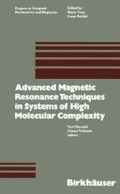Abstract
The question whether weak interactions between two molecules lead to the formation of a molecular complex or should only be seen as an effect of the preferential solvation is complicated and has been the subject of many investigations (1). To give a precise definition of the term “molecular complex” is a difficult task. One explanation is given by Mulliken and Person (2) who describe molecular complex as a type of an association, stronger than van der Waals interactions, but with the properties of the original molecules mostly preserved. On the other hand, according to Laszlo (3), the concept of “molecular complex” should have a more precise meaning and be used with more care. The problem is not only the strength of the interactions between the components, but also the lifetime of the complex. If the species exists during a period which is considerably shorter than the rotation correlation time, the question arises whether it is meaningful to describe the species as a complex.
Access this chapter
Tax calculation will be finalised at checkout
Purchases are for personal use only
Preview
Unable to display preview. Download preview PDF.
References
E.M. Engler and P. Laszlo, J. Amer.Chem.Soc. 93, 1317 (1971).
A.K. Covington and J.M. Thain, J. Chem.Soc. Faraday.Trans. I 1879 (1974).
H. Grahn, U. Edlund and G.C. Levy, J. Magn.Reson. 56, 61 (1984).
R.S. Mulliken and W.B. Person, “Molecular Complexes”, John Wiley and Sons, New York, 1969.
P. Laszlo, Progr.NMR Spectr. 13, 257 (1979).
A. Maliniak, J. Kowalewski and I. Panas, J. Phys.Chem. 88, 5628 (1984).
D.E. Woessner, J. Chem.Phys. 37, 647 (1962).
H. Shei, Q. Shen and R.L. Hilderbrandt, J. Mol.Struct. 65, 297 (1980).
Landolt-Börnstein “Zahlenwerte und Funktionen”, Springer-Verlag, West Berlin, 1969; Aufl., Bd II/5a.
B.I. Mattingley and D.V. Fenby, J. Chem.Therm. 7, 307 (1975).
Author information
Authors and Affiliations
Editor information
Editors and Affiliations
Rights and permissions
Copyright information
© 1986 Birkhäuser Boston, Inc.
About this chapter
Cite this chapter
Maliniak, A., Kowalewski, J. (1986). Nuclear Spin Relaxation Study of Weak Molecular Interactions in Benzene Solutions of Quinuclidine. In: Niccolai, N., Valensin, G. (eds) Advanced Magnetic Resonance Techniques in Systems of High Molecular Complexity. Progress in Inorganic Biochemistry and Biophysics, vol 2. Birkhäuser Boston. https://doi.org/10.1007/978-1-4615-8521-3_10
Download citation
DOI: https://doi.org/10.1007/978-1-4615-8521-3_10
Publisher Name: Birkhäuser Boston
Print ISBN: 978-1-4615-8523-7
Online ISBN: 978-1-4615-8521-3
eBook Packages: Springer Book Archive

